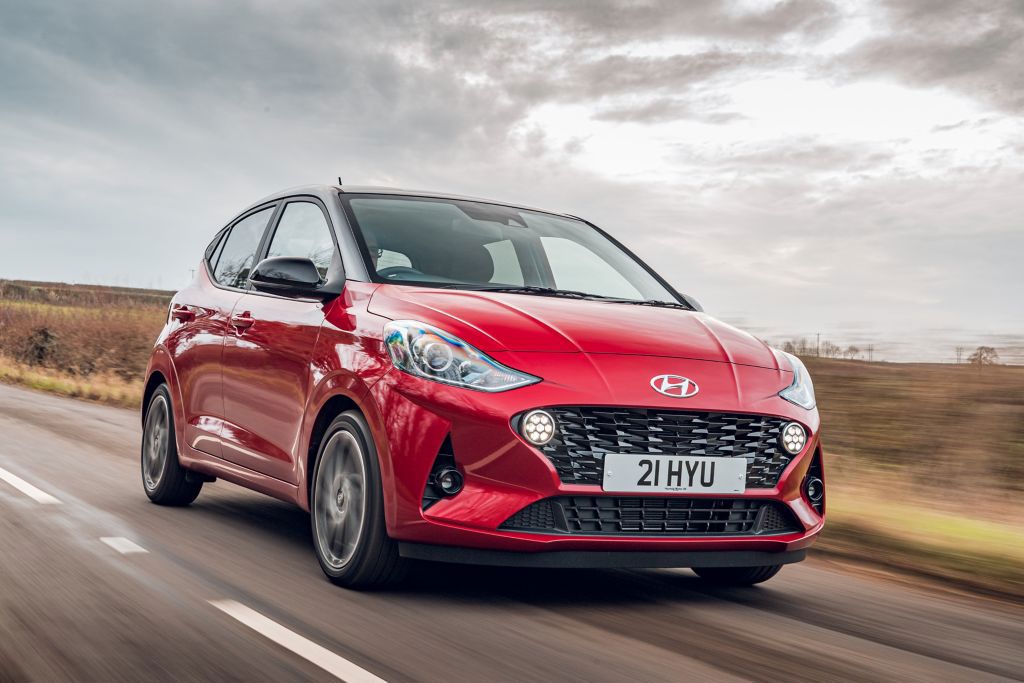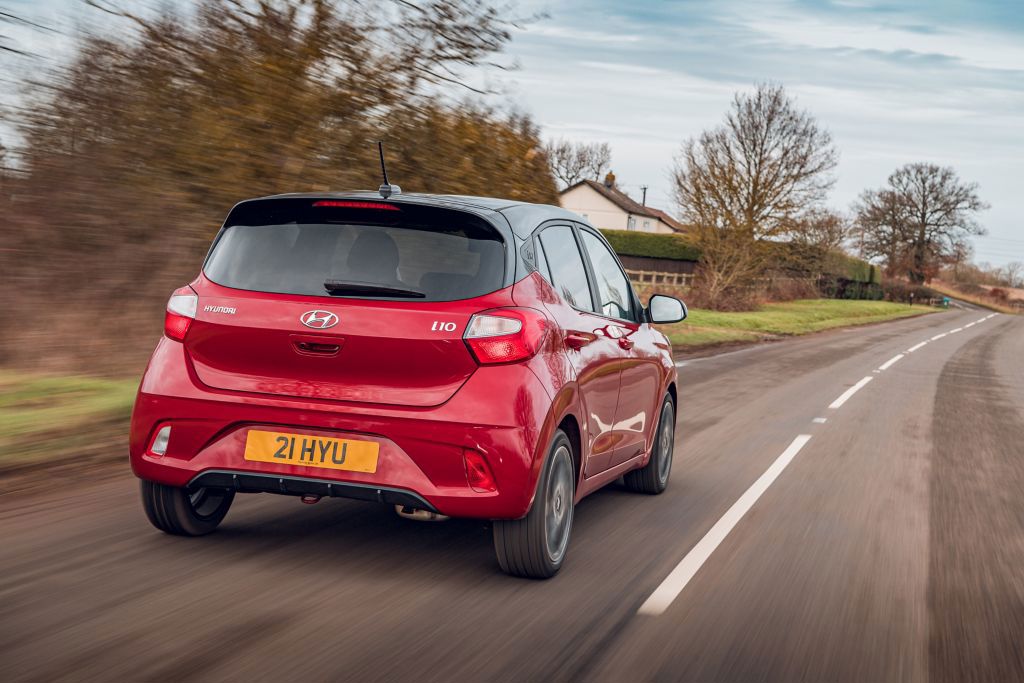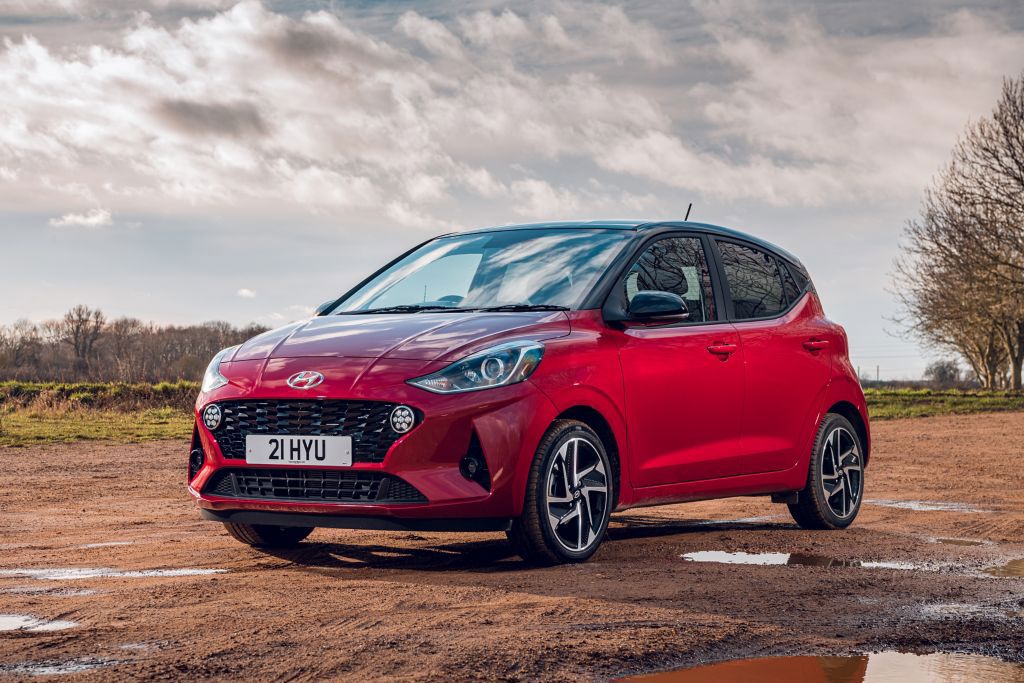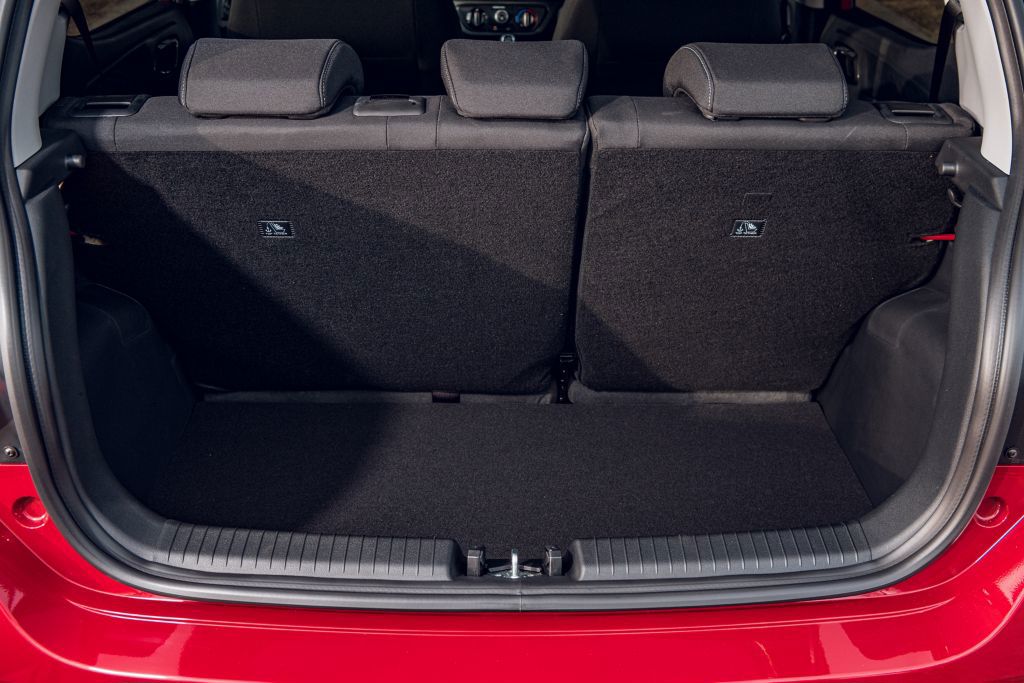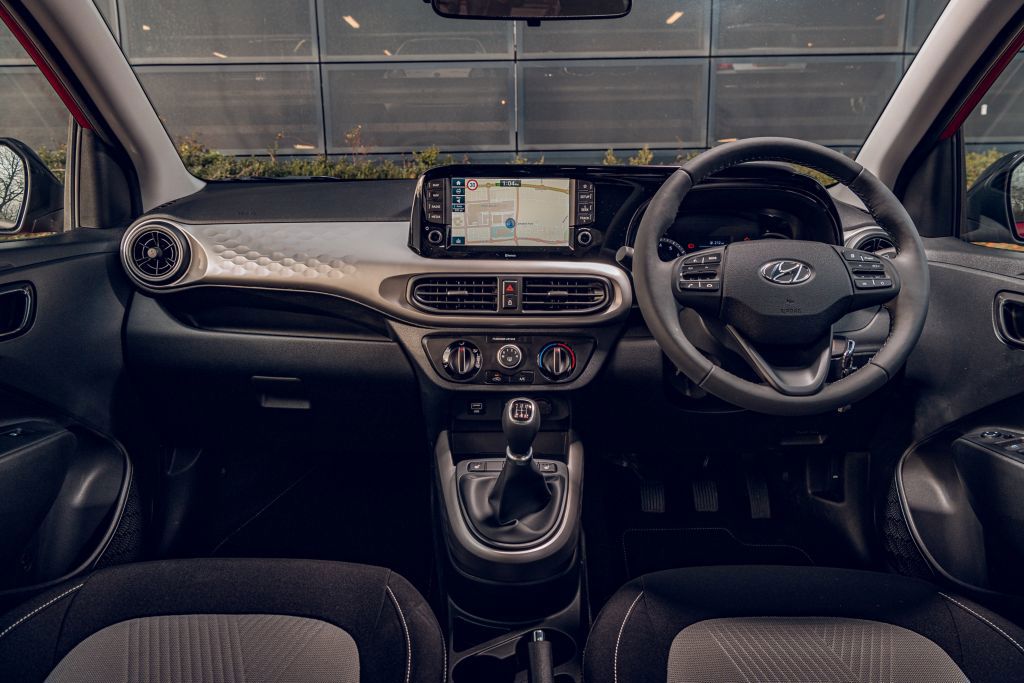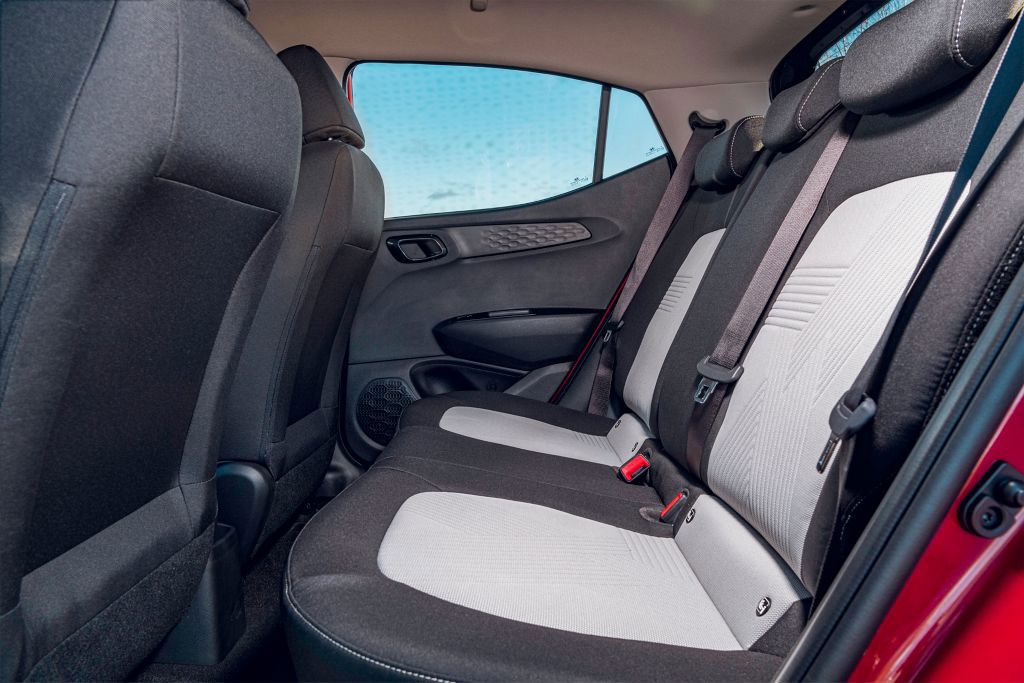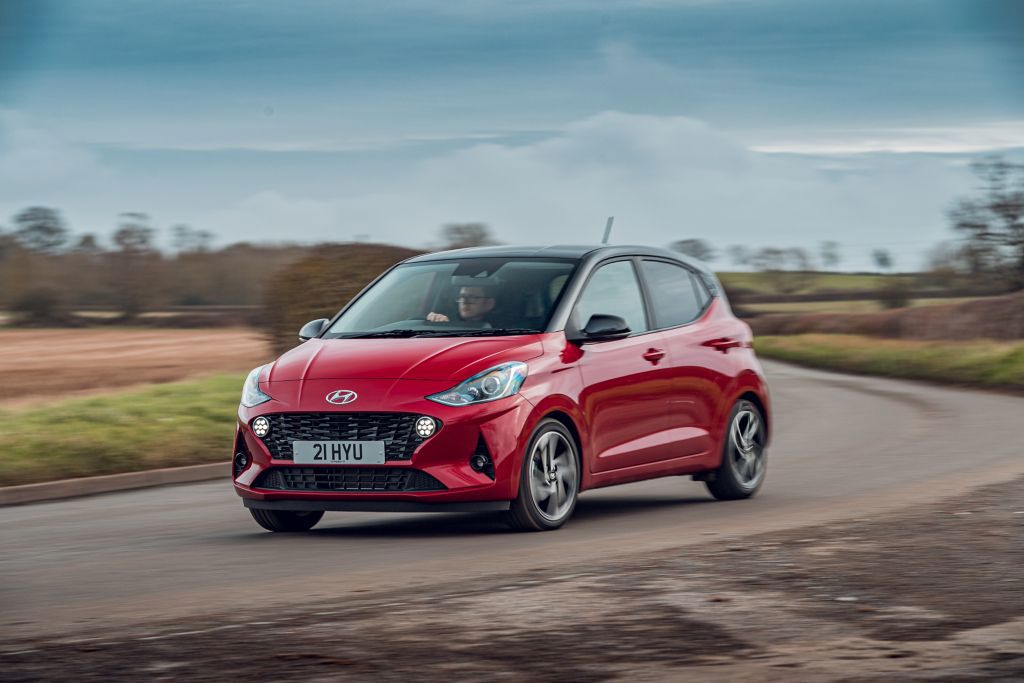Quick overview
- Excellent petrol engines
- Low running costs
- Cabin space
- Generous equipment
- Not the best in class to drive
- Crude auto ’box
- Mediocre safety rating
- Low-speed steering feel
When you want it all but don’t want to pay a lot for it or have a large car, you need a city car. This is where the Hyundai i10 scores very well as it provides the sort of interior space that makes you wonder why anyone would bother buying a car from the class above. The Hyundai i10 can carry four adults without any hint of complaint from those in the back seats, and it also has a bigger boot than most of its rivals, so you can fit in more luggage for trips away.
As this is a Hyundai, the i10 enjoys a solid reputation for reliability and it comes with a five-year, 100,000-mile warranty from new. That’s a lot of peace of mind, and you won’t grumble at the affordable running costs of the Hyundai i10, either, as this is a small car that makes a virtue of economy and low emissions.
Power for the i10 comes from a chirpy 1.0-litre petrol engine with 67hp or a 1.2-litre with 84- or 100hp. The more potent 1.2 is only offered with the top level N Line trim, but you can have the 1.0-litre motor or the 84hp 1.2 with five-speed manual or automatic gearboxes. The manual is an ideal partner to the i10, but the automatic is not the smoothest at changing gear as its an automated manual rather than a more traditional auto ’box.
While it’s worth giving this gearbox a miss, you won’t miss out when it comes to equipment. The i10 is fitted out to a high degree in all trims and every version comes with air conditioning, DAB stereo, height adjustable driver’s seat, and leather-trimmed steering wheel. It’s a pity the i10 didn’t score more highly in Euro NCAP tests, but all models come with lane departure and lane keep assist tech, as well as automatic emergency braking.
Prices
The Hyundai i10 SE is only offered with the 1.0-litre 67hp engine and five-speed manual gearbox, with a price of £13,430. Move up the SE Connect with the same engine and gearbox, and you’ll pay £1000 more. The automatic gearbox is a £500 option or you can spend £800 to go from the 1.0-litre engine to the 84hp 1.2. To make the jump to the Premium Trim will add £1250 to the price of the i10, with this model starting from £15,435. The N Line is the only trim to use the 100hp 1.0-litre turbo petrol motor and costs from £16,560. There are savings of between £500 and £1000 on new Hyundai i10 models, depending on trim. If you’re happy to look at a nearly new example, you could save as much as £1500 for a car with around 3000 miles on the clock. For a two-year old i10, prices start at around £12,000 for an SE Connect with 15,000 miles under its wheels.
Infotainment, comfort and practicality
Space is not something you will have to worry about in the Hyundai i10. Up front, the driver gets into the car through a big aperture left by the wide-opening door. The seat is also at the right height so you just step into the i10 without having to slump down or lift yourself up. The driver’s seat in all models comes with height adjustment, and there’s plenty of fore and aft movement so drivers of all statures can get comfy. Hyundai doesn’t equip the i10 with reach adjustment for the steering wheel, but it does move for angle and it doesn’t hinder you finding the right seating position.
The view out for the driver is very good in the Hyundai i10 in all directions. Its compact exterior helps here, which is just as well as there isn’t even the option of parking sensors. Still, all but the base trim level come with a rear parking camera to help out in tight spots. The Premium and N Line models also have heated front seats, which is a welcome and warming option to have on cold mornings. In the summer, every i10’s cabin can be cooled by standard air conditioning.
In front of the driver, the main instrument binnacle is clear and easy to read. Two round dials for revs and speed sit either side of a small digital display for the onboard computer that shows the usual data. You also have steering wheel buttons to scroll through these functions onscreen. The thick-rimmed steering wheel feels a bit sportier than most of the i10’s rivals and its leather trim adds a touch of quality to the cabin missing in many city cars. Move your left hand towards the gear lever and it’s a pleasingly short stretch, while the heater controls are simple rotary dials in the centre console. Below them is a storage tray, which doubles as a wireless phone charger in the higher two trim levels. There’s also a double cupholder between the front seats and a small oddments tray, while the door bins are a reasonable size.
Further up on the dash, the base Hyundai i10 SE model makes do with a small digital readout for the stereo. In all the other trims, you get a much more handsome integrated 8.0-inch colour touchscreen that can be connected to your phone with Android Auto or Apple CarPlay to access apps and sat-nav. This is just as well as only the SE Connect model is not supplied with navigation, whereas the Premium and N Line are. Unlike some infotainment set-ups, the Hyundai’s comes with physical shortcut buttons and a couple of knobs to turn for volume and menus swapping.
Move into the back of the Hyundai i10 and you’ll find generous space for two adults, though three is pushing your luck. A couple of kids will be more than happy back here and you could sneak in a third in the middle seat as the bench is broad and flat. There’s also a third three-point belt for this passenger, while Isofix mounts are fitted to the outer back seats to securely fasten child seats in place.
The i10’s boot offers 252-litres with the rear seats up and a surprisingly large 1050-litres with the 60-40 rear cushions tipped forward. When laid down, these cushions create a flat floor, though there is a bit of a drop from load sill to boot floor. However, the tailgate opening is wider than most in this class and a very even rectangular shape.
Which 2020 Hyundai i10 model should you buy?
The SE trim for the Hyundai i10 comes with 14-inch steel wheels, electric front windows, hill-start assist, forward collision warning and avoidance systems, high-beam assist, and lane departure warning and lane keep assistance. There’s air conditioning to cool the inside, driver attention warning, cruise control, and electrically adjusted door mirrors. The steering wheel is trimmed in leather with remote buttons for the stereo and cruise control, a DAB digital radio, and Bluetooth connection. The SE Connect adds 15-inch alloy wheels and a rear-view camera. You also get two rear speakers for the stereo, and the 8.0-inch infotainment touchscreen with Android Auto and Apple CarPlay, plus Bluetooth with voice recognition. On top of this, the Premium trim comes with 16-inch alloy wheels, chrome door handles, front foglights and LED daytime running lights, and a contrasting colour for the roof. Inside, there are heated front seats and steering wheel, keyless entry and ignition, and a wireless charging pad for your phone. The infotainment also gains sat-nav. For the N Line, as well as its unique engine, you get all the Premium has to offer plus N Line design alloy wheels, and N Line styling accents for the body and interior.
Value for money: how much does a 2020 Hyundai i10 cost to buy and run?
Keeping a Hyundai i10 on the road won’t take much from your wallet thanks to combined fuel economy of 56.5mpg and 114g/km carbon dioxide emissions for the 67hp 1.0-litre engine with manual gearbox. Go for the auto and those figures become 51.4mpg and 126g/km. The 84hp 1.2-litre engine provides 52.3mpg and 124g/km with the manual transmission, while the auto returns 49.6mpg and 129g/km. The N Line’s 100hp turbo petrol 1.0-litre serves up 52.3mpg and 123g/km. All i10s attract a first-year VED road tax rate of £190, while insurance is between groups 3 and 10 depending on trim, engine and gearbox.
Verdict: Should I buy a 2020 Hyundai i10?
Quite simply, the Hyundai i10 is a cracking city car. This is true whether you need something small and nimble to get through congested streets with the minimum of fuss, or carry the family around town while still having a reasonable amount of room for shopping in the boot. The i10 does it all and it also makes a very good job of venturing further afield thanks to peppy engines and good ride comfort on bumpy roads.
The entry-point SE trim is well equipped, though we’d head towards the SE Connect to enjoy a few added luxuries such as the 8.0-inch infotainment touchscreen, and heated seats. There’s plenty of safety kit in the i10 too, though it doesn’t have the best score in the class in Euro NCAP tests.


